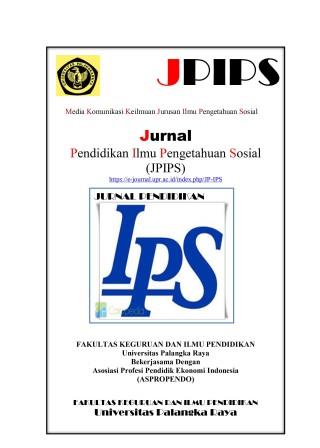Analisis SWOT Terhadap Pelaksanaan Strategi Pemasaran Madu Kelulut Pada Kelompok Usaha Desa Petak Puti
DOI:
https://doi.org/10.37304/jpips.v14i1.4742Keywords:
SWOT Analysis, Marketing Strategy, Honey Kelulut, Business GroupAbstract
The purpose of this study was to obtain data about the marketing strategy applied by the honey kelulut business group community, to know the implementation of the marketing strategy, to know the results of the SWOT analysis on the implementation of the marketing strategy and to find out the problems faced by the kelulut honey business group community in Petak Puti Village. This study uses a descriptive research method with a qualitative approach or data collection, interviews, observations and documentation. The subject of this research is the community of the honey kelulut business group in Petak Puti Village. The data analysis technique in this study used an interactive qualitative descriptive data analysis model consisting of three concurrent activity lines, namely: data reduction, data presentation, and conclusion drawing. Based on the results of research and interviews, it was shown that at first this kelulut honey bee colony was an aid from the government. How to add a colony apart from government assistance, is also looking for colonies of honey bee kelulut in the forest or breaking up colonies of honey bee kelulut that already exists. In addition to maintaining stup assistance from the government, they also look for kelulut honey bee colonies in the forest around the village and break up existing colonies, so that these colonies can later grow. As well as planting flowers that have enough pollen so that it can increase the productivity of the honey produced. The influencing factors are the cleanliness of the stup, the safety of the stup from rainy or hot weather, and also guarding against nuisance animal attacks. There are two kinds of stup, namely stup made of wood logs taken from the forest which directly have the colony and some are made of boards, the stup is for the transfer of the colony. The post-harvest honey process is filtered into closed jars, allowed to stand for 2-3 days to reduce foam at the time of harvest, then poured into packaged bottles. The group entrusts the marketing of honey to the assistants, so that the assistants who market to the City of Palangka Raya and its surroundings go through agents/collectors in that city
Downloads
References
Assauri, Sofjan. (2002). Manajemen Pemasaran, Konsep Dasar Strategi. Jakarta: PT. Raja Grafindo Persada.
Adji Suranto. 2008. Khasiat dan Manfaat Madu Herbal. Jakarta: PT. AgroMedia Pustaka.
Al Fady, Moh. Faisol. (2015). Madu dan Luka Diabetik. Yogyakarta: Gosyen Publishing.
Arikunto, Suharsimi. (2006). Prosedur Penelitian Suatupendekatanpraktik. Jakarta: Rineka Cipta.
Buchari, Alma. (2007). Manajemen Pemasaran edisi revisi. Jakarta LP-FEUI.
Cahandra, Gregorius. (2001). Service Quality and Satisfacation. Yogyakarta: Andi
Daryanto. (2011). Sari Kulia Manajemen Pemasaran. Bandung: PT. Sarana Tutorial Nurani Sejahtera
David. (2006). Manajemen Strategik. Jakarta: Salemba Empat
Frinces, Heflin. (2006). Manajemen Strategik. Jogjakarta: Media Pustaka.
Fendy Hariatama. (2021). Analisis SWOT Terhadap Pelaksanaan Bauran Pemasaran (Marketing Mix) Pada Lembaga Pendidikan Prima Mandiri Utama Palangka Raya. Edunomics Journal. Vol 2 no 1. Hal 1-12. https://e-journal.upr.ac.id/index.php/edu/article/view/2078.
Goh, T.H Sunny, dan Khoo Kheng-Hor. (2005). Marketing Wise. Jakarta: PT. Bhuana Ilmu Populer
Hurriyati, Ratih. (2005). Pemasaran dan Loyalitas Konsumen. CV. Alfa Beta: Bandung.
Joko Subagyo. 2011. Metode Penelitian Dalam Teori Dan Praktik. Jakarta: Rineka Cipta.
Kotler, Philip. (2006). Manajemen Pemasaran, Analisis Perencanaan, Implementasi dan Kontrol. Jakarta: Prenhalindo.
–––––––––––. (2009). Manajemen Pemasaran edisi 13. Jakarta: Erlangga.
Moleong, Lexy J. (2007).Metodologi Penelitian Kualitatif. Bandung: PT. Remaja Rordakarya.
Mulyadi. (2007). Sistem Perencanaan dan Pengendalian Manajemen. Jakarta: Salemba Empat
Rangkuti, Freddy. (2004). Analisis SWOT Teknik Membedah Kasus Bisnis. Jakarta: Gramedia Pustaka Utama.
–––––––––––––––. (2006). Analisis SWOT Teknik Membedah Kasus Bisnis. Jakarta: Gramedia Pustaka Utama.
Rodiosunu. (2001). Kerangka Dasar Manajemen Pemasaran. Bandung: Tristo. Sugiyono. (2009).Metode Penelitian Bisnis (Pendekatan Kuantitatif, Kualitatif, dan R&D), Bandung: CV. Alfabeta.
Rinto Alexandro, Windy Utami Putri, Yanti Nurmawati. (2020). Analisis SWOT Pada Pemasaran Batik Benang Bintik Lestari Indah Palangka Raya. EKUITAS: Jurnal Pendidikan Ekonomi. Vol 8 No 1 hal 71-79. https://ejournal.undiksha.ac.id/index.php/EKU/article/view/24689.
Rinto Alexandro, Richard A Butarbutar, Tonich Uda, Dehen Erang. (2021). Analisis Strategi Pemasaran Dalam Meningkatkan Volume Penjualan Pada Cell Com Palangka Raya (Analysis Of Marketing Strategy In Increasing Sales Volume At Cell Com Palangka Raya). Neraca: Jurnal Pendidikan Ekonomi. Vol 7 No 1. Hal 1-6. http://journal.umpalangkaraya.ac.id/index.php/neraca/article/view/2495.
Rima MEILINDA. (2020). Analisis SWOT Marketing MIX Pada SMA Muhammadiyah 1 Palangka Raya. Edunomics Journal. Vol 1 no 1 hal 8-13. https://e-journal.upr.ac.id/index.php/edu/article/view/1611.
Swastha, Basu. (2002). Manajemen Pemasaran. Edisi Kedua. Cetakan Kedelapan. Jakarta: Liberty.
Sundari Sundari, Eko Riadi, Rinto Alexandro, Fendy Hariatama, Merisa Oktaria. (2022). Analisis SWOT Dan Strategi Pemasaran Usaha Waralaba (Studi Kasus Pada Cokelat Klasik Palangka Raya). Edunomics Journal. Vol 3 No 1 Januari 2022. Hal 1-10. https://e-journal.upr.ac.id/index.php/edu/article/view/3871.
Sundari Sundari, Revnussa Oktobery, Jacob Abolladaka. (2021). Strategi Usaha Dengan Analisis SWOT Pada Rental Adinda Palangka Raya. Jurnal Pendidikan Ilmu Pengetahuan Sosial (JPIPS). Vol 12 no 1. Hal 49-56. https://e-journal.upr.ac.id/index.php/JP-IPS/article/view/1135.
Wahyudi, (2004). Manajemen Sumber Daya Manusia, Bandung: Sulita
Wulansari, D. (2018). Madu Sebagai Terapi Komplementer. Yogyakarta: Graha Ilmu














